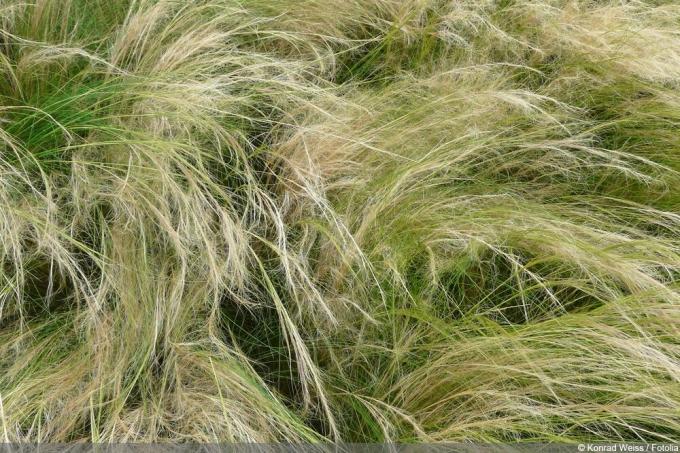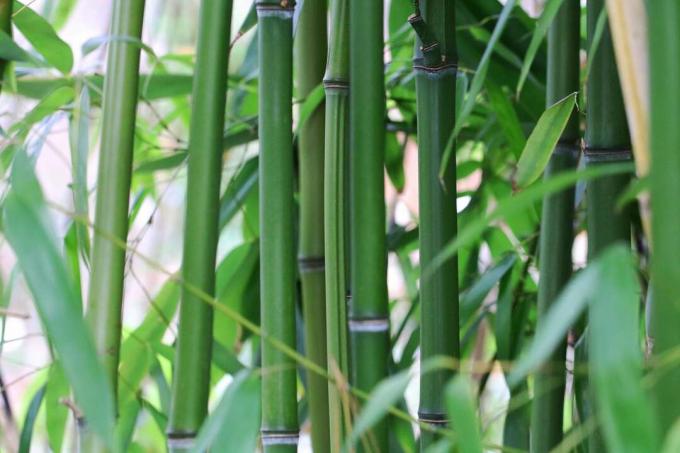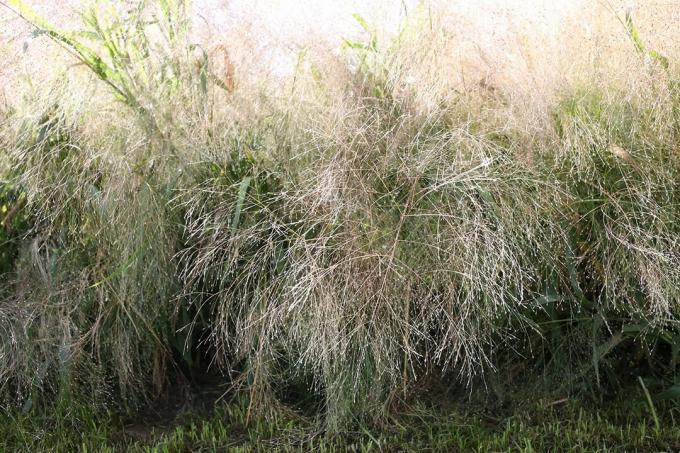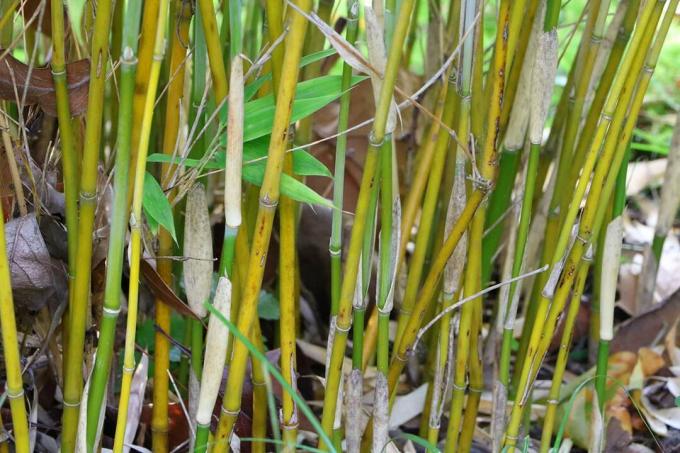

Table of contents
- location and soil
- Plant
- use
- planting partner
- propagation
- Split
- Pour
- Fertilize
- Cut
- tub cultivation
- hibernate
- diseases and pests
The angel hair feather grass (Stipa tenuissima) originally comes from Mexico and Argentina. The grass has gained popularity as an ornamental plant due to its nodding panicles of flowers, which are aesthetically pleasing with their feathery shape. In direct sunlight, the long awns glow in silvery and white hues. Impressive scenery is created, especially in groups, when the inflorescences in the wind are reminiscent of the gentle waves of a sea.
location and soil
Stipa tenuissima grows naturally on dry and nutrient-poor grassland. You should also offer the grass these conditions in the garden. The Maidenhair Grass prefers a sunny location. It thrives in partial shade if the soil ensures dry conditions. A calcareous substrate that has high permeability is ideal for cultivating the grass species. Heavy clay and loam soils are not suitable. Plant angel hair grass on a rocky or gravelly surface. The plant thrives in nutrient-poor soils. Nutrient-rich soils should be thinned out beforehand.
Tip:
Plant the grass on south-facing patio slopes. In addition to coneflowers and hydrangeas, angel hair grass is particularly effective.
Plant
The feather grass can be planted in autumn or spring. If you want to place several specimens in small groups, you should ensure a distance of 30 to 40 centimeters. As a basis for the optimal planting distance, you can use the expected growth width as a guide. The root ball is placed as deep in the ground as it was in the pot.
- plenty of time to grow in spring planting
- grasses planted in spring are more resistant to frost
- Young plants planted in autumn need winter protection
use
Maidenhair grass is suitable for planting in naturally designed gardens that offer dry and lean areas. It adorns rocky steppes or rock gardens. Here they can be scattered individually or planted in groups. The feathery spikes are particularly effective in Asian gravel beds. The feather grass provides variety between the lilac-colored plants in the heath garden. As a structure giver, the ornamental plant is suitable for small front gardens. It can be planted to stabilize slopes or cultivated in tubs. After the flowering period, the ornamental value of the grasses decreases somewhat, so you should include plants with a later flowering period in the planting.
Tip:
Plant the grass on south-facing patio slopes. At these locations, angel hair grass is particularly effective alongside coneflowers and hydrangeas.
planting partner
Perennials with eye-catching flowers or tightly upright growth forms are suitable as neighbors. In a group of feather grass, the burgundy flowering ball leek stands out. Perennials with similar site requirements are well suited as planting partners.
- Ivory thistles (Eryngium giganteum) harmonize with feather grasses thanks to their bizarre growth
- blue flowering catnip (Nepeta) provide color accents
- Stonecrops (Sedum) look attractive in the foreground
propagation
Maidenhair grass propagates successfully by self-sowing. The seeds are dispersed after flowering when the spikes are blown about by the wind. They have an awn that twists into the ground when it comes into contact with water. This is how the seeds anchor themselves in the ground. Already in the first spring after planting, new young plants appear around the mother plant. You can get the seedlings out of the substrate in spring and transplant them to another location. An alternative propagation method is to collect the seeds that will be sown next spring. The cold germs need a cold stimulus that stimulates the formation of the cotyledons.
- Fill the box with nutrient-poor growing substrate
- Scatter seeds and cover lightly with soil
- Keep substrate evenly moist
- put in a place with temperatures around 18 degrees Celsius for four weeks
- Then place the box in a room with ten degrees Celsius for a week
- then the box is placed outside
- Germination takes place after a cold stimulus, which lasts four to eight weeks
Split

Garden forms can be divided in spring when the clumps become too large. To do this, the root ball is dug up and placed on a solid surface. The bale is divided into several sections with a sharp spade. They should not be too small, otherwise they will grow poorly and show stunted growth. Ideally, a section has three to four shoots.
Pour
As a drought-loving plant, angel hair does not need to be watered. It easily tolerates brief periods of heat during the summer. If the rain-free period lasts longer, you can occasionally water the nests. The roots do not tolerate waterlogging. It often becomes a problem during too wet winter months or when cultivating in tubs.
- Water potted plants regularly and sparingly
- Substrate may dry up to three centimeters deep before the next watering
- keep watering until water drips out of the drainage hole
- Remove excess water from coasters immediately
- water at the base to prevent fungus and pest spread
Fertilize
A regular supply of nutrients is not necessary because the grass is adapted to nutrient-poor locations. Over-fertilization weakens the vitality of the plant, making it more susceptible to disease. You can provide young plants with rock dust or horn shavings in the spring. This nutrient supply is carried out in April for the first two to three years. If growth stagnates or the Maidenhair Grass does not bloom, fertilization can help. Use a liquid fertilizer at a very low concentration.
Tip:
Give the plants a heavily diluted brew of plant juices, coffee grounds or black tea if they are showing signs of weakness. These agents prevent over-fertilization.
Cut
The clumps are cut back between February and March. This measure ensures that the fresh shoots get enough light. Cut back the clumps to 10 to 15 centimeters. For a clean cut, grab the stems of a clump above the ground so the leaves are bunched in your hand. The stems can now be cut off with sharp pruning shears. Once the flowers have withered, they can be cut off. They are suitable for drying bouquets and flower vases. Dead plant parts remain over the winter, as the clumps fulfill various protective functions.
- Rainwater runs off the leaves so that the root ball does not get wet
- withered stems and leaves insulate the soil from the cold
- Insects overwinter in the hollow stems
- straw-like clumps look decorative in winter
Tip:
You don't necessarily have to cut the clumps in spring. It is enough to comb out the withered parts of the plant with your fingers.
tub cultivation
If you want to plant the maidenhair grass in a pot, you should choose a bucket with a capacity of five liters. A bottom opening ensures that the irrigation water can drain off. Cover the bottom of the pot with pebbles, expanded clay or potsherds. This layer acts as a drain and prevents the substrate from trickling out of the drain hole. Fill the tub with a lean substrate that has a high calcium content and is permeable.
- Clay or terracotta pots are more suitable than plastic
- natural materials are porous and absorb water
- Moisture evaporates on the outside
hibernate

Maidenhair grass is hardy. The above-ground parts of the plant die off shortly before the onset of winter. They serve as natural protection against the cold in winter and ensure that the root area does not become waterlogged. Tie the stems of a clump together with sisal just above the ground. This measure prevents the water from flowing down the stalks to the ground. If you cut the clumps in the fall, you should cover the ground with branches of spruce or fir. A thick layer of straw or twigs provides the same benefits. Potted plants need additional protective measures because the substrate freezes quickly. Wrap the pot with fleece, jute or foil and place it on a styrofoam plate. A wooden board is also suitable as insulation so that the frost does not penetrate the substrate.
diseases and pests
The angel hair grass proves to be a robust ornamental plant that does not fall victim to either pathogens or pests. Incorrect care measures can lead to rotting of the roots. These processes are favored by a moist substrate. Rotten roots and stems provide ideal growth conditions for fungal spores. They settle on the rotten plant parts and accelerate the decomposition processes. The ornamental grass lets its leaves droop and suffers from growth disorders.
- Dig up nest and check for damage
- cut off rotten roots
- place in dry substrate
- avoid watering
 garden editorial
garden editorial I write about everything that interests me in my garden.
Learn more about ornamental grasses

cutting bamboo | When and how to cut back bamboo?
Be it as a hedge, solitaire or ground cover, bamboo can be seen more and more often in home gardens. Because the sweet grass is easy to care for and easy to grow. However, the latter can quickly become a problem if the plants are not pruned regularly.

11 Tips for Cutting Grasses | Tools & Co.
Cutting ornamental grass works best with our tips: From choosing the right tool to right time - we have the most useful tips and tricks for you for the annual grass cut summarized.

Switchgrass, Panicum virgatum: Care from A – Z
Switchgrass is an upright-growing, clump-forming grass with narrow leaves. The species is considered to be easy to care for and makes few demands on location and soil. Read how to optimally plant and care for Panicum virgatum.

Zebra grass, Miscanthus sinensis 'Strictus': care from A - Z
In botanical jargon, zebra grass is also called Miscanthus sinensis 'Strictus'. The plants can be used wonderfully as privacy screens and are decorative. From care in the tub to overwintering: You can find information on care from A - Z here.

Grow pampas grass from seeds: we explain how
Pampas grass is considered easy to cultivate and can be successfully propagated by breeding. Under controlled conditions in the planter, the germination success is higher than with direct outdoor sowing. The procedures regarding substrate, choice of location and care hardly differ in these variants.

Grasses as a privacy screen: 20 tall grasses
Numerous grasses are ideal as privacy screens! We present the 20 most popular grasses in this article!



